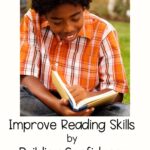Students often lack confidence in their reading skills resulting in decreased motivation to read and/or learn. Learn what teachers can do to empower students with the confidence they need to succeed in their reading skills.
Reading is one of the foundational skills that students learn in elementary school. Unfortunately, not all students have developed the same level of confidence when it comes to reading.

Students may struggle with comprehension, decoding, or fluency, which can affect their motivation to learn. Struggling readers lack confidence, which can cause them to become more reluctant to read.
As a teacher, you can help your students build confidence in their reading skills, which can improve their enjoyment of reading, increase their motivation to learn, and ultimately lead to better academic outcomes (Schunk & Mullen, 2012). In this blog post, we’ll explore some strategies for giving your students confidence in their reading skills.
Create a Safe and Supportive Environment
One of the most important goals for teachers is to create a safe and supportive environment for their students. This means creating a classroom culture where students feel respected, valued, and encouraged.
When students feel safe and supported, they’re more likely to take risks and try new things. Teachers should explain that it’s okay to make mistakes and that learning is all about trying. Students will begin feeling more comfortable making mistakes as they learn and know they won’t be laughed at.
Promoting a positive mindset about mistakes and learning will help improve reading skills. Students learn to view mistakes as normal steps in learning instead of failures.
You can create a safe and supportive environment by setting clear expectations, providing positive feedback, and celebrating students’ successes.
Use Evidence-Based Instructional Strategies
Evidence-based instructional strategies are vital for helping students build their reading skills.
Evidence-based strategies are teaching methods that have been proven to work. This means they’ve been tested in many classrooms, and there’s research to show that students learn better with these methods. Teachers can use these strategies to help make sure students learn as much as possible and remember what they learned afterward.
For example, you can use decoding and fluency activities to help students improve word recognition and reading speed.
You can also use comprehension strategies, such as prediction, visualization, and questioning, to help students understand and remember what they’ve read.
Students’ engagement is boosted when students work together collaboratively together (Wentzel, 2009). Try having students work with partners or small groups to play games and solve puzzles together. Additionally, hands-on learning can make learning more meaningful and help students remember and recall information they’ve learned (Copperstein and Kocevar-Wiedinger, 2004).
Provide Individualized Feedback and Support
Another way to help your students build confidence in their reading skills is to provide individualized feedback and support.
Specifically, this means taking the time to observe your students’ reading behaviors, identify strengths and weaknesses, and provide specific feedback and support for improvement.
Data and assessment tools should be used to track students’ progress. That data can be used to tailor instruction to students’ individual needs. Providing individualized lessons, feedback, and support that address individual needs will enhance students’ confidence in their reading abilities.

Encourage a Love of Reading
Finally, one of the best ways to give your students confidence in their reading skills is to foster a love of reading. When students enjoy reading, they’re more likely to read independently, practice their skills, and take pride in their accomplishments.
You can boost your students’ love of reading by providing a variety of engaging and relevant reading materials, such as books, magazines, and online resources. You can also model positive reading behaviors, such as reading aloud, discussing books, and sharing your own love of reading.
By creating a safe and supportive environment, using evidence-based instructional strategies, providing individualized feedback and support, and fostering a love of reading, you’ll increase your students’ motivation and confidence.
When students feel confident in their abilities, they’re more likely to enjoy reading, be motivated to learn, and ultimately achieve better academic outcomes. As a teacher, you have the power to build students’ confidence to improve reading skills and set them on a path toward lifelong learning.

What resources can I use in my classroom?
Teachers can help students understand passages and texts better by giving them text evidence passages. These activities encourage students to read more closely, think about what they’ve read, and practice critical thinking skills.
The objective of these passages is for students to find the details that support the main ideas of the passage. Practicing these skills with interactive activities can increase your students’ reading skills, helping them perform better in school.
As an added bonus, text evidence passages save teachers valuable time when preparing lessons.
Be sure to check out the BUNDLE of seasonal reading passages at my TPT shop.
Want to learn more about text evidence and reading instruction?
How to Teach Students to Cite Text Evidence
How to Teach Compare and Contrast Essays
5 Tips to Prep Your Students for State Testing









